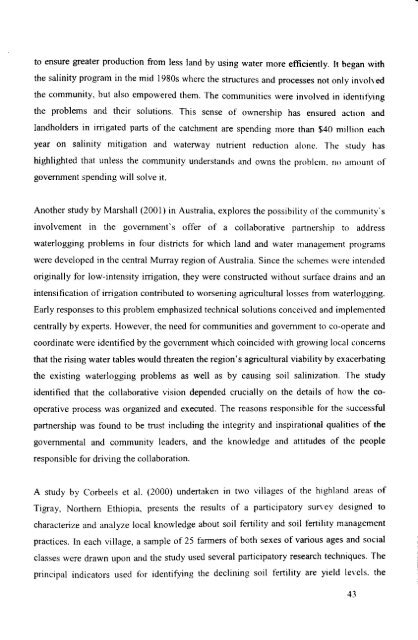Water Users Association and Irrigation Management - Institute for ...
Water Users Association and Irrigation Management - Institute for ...
Water Users Association and Irrigation Management - Institute for ...
Create successful ePaper yourself
Turn your PDF publications into a flip-book with our unique Google optimized e-Paper software.
to ensure greater production from less l<strong>and</strong> by using water more efficiently. It began with<br />
the salinity program in the mid 1980s where the structures <strong>and</strong> processes not only involved<br />
the community, but also empowered them. The communities were involved in identifying<br />
the problems <strong>and</strong> their solutions. This sense of ownership has ensured action <strong>and</strong><br />
l<strong>and</strong>holders in irrigated parts of the catchment are spending more than $40 million each<br />
year on salinity mitigation <strong>and</strong> waterway nutrient reduction alone. The study has<br />
highlighted that unless the community underst<strong>and</strong>s <strong>and</strong> owns the problem. no amount of<br />
government spending will solve it.<br />
Another study by Marshall (2001) in Australia, explores the possibility of the community's<br />
involvement in the government's offer of a collaborative partnership to address<br />
waterlogging problems in four districts <strong>for</strong> which l<strong>and</strong> <strong>and</strong> water management programs<br />
were developed in the central Murray region of Australia. Since the schemes were intended<br />
originally <strong>for</strong> low-intensity irrigation, they were constructed without surface drains <strong>and</strong> an<br />
intensification of irrigation contributed to worsening agricultural losses from waterlogging.<br />
Early responses to this problem emphasized technical solutions conceived <strong>and</strong> implemented<br />
centrally by experts. However, the need <strong>for</strong> communities <strong>and</strong> government to co-operate <strong>and</strong><br />
coordinate were identified by the government which coincided with growing local concerns<br />
that the rising water tables would threaten the region's agricultural viability by exacerbating<br />
the existing waterlogging problems as well as by causing soil salinization. The study<br />
identified that the collaborative vision depended crucially on the details of how the cooperative<br />
process was organized <strong>and</strong> executed. The reasons responsible <strong>for</strong> the successful<br />
partnership was found to be trust including the integrity <strong>and</strong> inspirational qualities of the<br />
governmental <strong>and</strong> community leaders, <strong>and</strong> the knowledge <strong>and</strong> attitudes of the people<br />
responsible <strong>for</strong> driving the collaboration.<br />
A study by eorbeeIs et al. (2000) undertaken in two villages of the highl<strong>and</strong> areas of<br />
Tigray, Northern Ethiopia, presents the results of a participatory survey designed to<br />
characterize <strong>and</strong> analyze local knowledge about soil fertility <strong>and</strong> soil fertility management<br />
practices. In each village, a sample of 25 farmers of both sexes of various ages <strong>and</strong> social<br />
classes were drawn upon <strong>and</strong> the study used several participatory research techniques. The<br />
principal indicators used <strong>for</strong> identifying the declining soil fertility are yield le\·els. the<br />
43
















